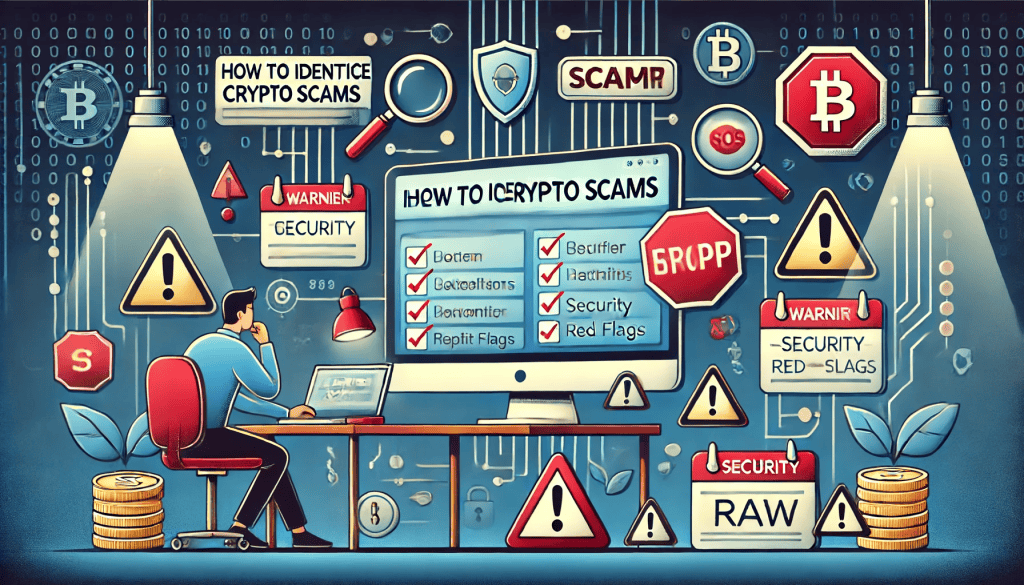Cryptocurrency continues to gain popularity, attracting not only legitimate investors but also scammers. In 2024, the rise in crypto scams poses a significant threat to both new and seasoned investors. Understanding how to identify and avoid these scams is crucial to protecting your assets. This guide on how to avoid crypto scams in 2024 provides essential tips and strategies to help you navigate the crypto landscape safely. By following these steps, you can minimize risks and make informed decisions. The following sections will delve into various types of scams, preventive measures, and best practices for ensuring your cryptocurrency investments remain secure.
Types of Crypto Scams

Understanding the types of crypto scams is the first step toward prevention. Scammers often use sophisticated techniques to deceive investors. Here are some common scams to be aware of:
- Phishing Scams
- Phishing scams involve tricking individuals into revealing their private keys or other sensitive information. Scammers often use fake websites, emails, or messages that appear legitimate.
- Ponzi Schemes
- Ponzi schemes promise high returns with little risk. These scams use funds from new investors to pay returns to earlier investors, eventually collapsing when new investments dry up.
- Fake Exchanges
- Fake exchanges lure investors with attractive rates and promises of high returns. Once users deposit their funds, the scammers disappear, taking the money with them.
- ICO Scams
- Initial Coin Offering (ICO) scams involve fraudulent projects that claim to offer new cryptocurrency tokens. Scammers collect funds from investors and then vanish without delivering the promised tokens.
- Pump and Dump Schemes
- In pump and dump schemes, scammers artificially inflate the price of a cryptocurrency by spreading false information. Once the price peaks, they sell off their holdings, causing the price to crash and leaving other investors with losses.
How to Identify Crypto Scams

Being able to spot red flags can help you avoid falling victim to crypto scams. Here are some indicators to watch out for:
- Unrealistic Promises
- Be wary of any investment opportunity that promises guaranteed returns or exceptionally high profits with little to no risk.
- Lack of Transparency
- Legitimate projects provide detailed information about their team, technology, and business model. If this information is missing or unclear, it may be a scam.
- Pressure to Act Quickly
- Scammers often create a sense of urgency to pressure you into making hasty decisions. Take your time to research and verify the legitimacy of any investment.
- Unsolicited Offers
- Beware of unsolicited offers or messages from unknown sources, especially those that require you to provide personal information or make immediate payments.
- Poorly Designed Websites
- Fake websites often have poor design, grammatical errors, and lack secure connections (look for HTTPS). Verify the website’s authenticity before entering any personal information.
Tips for Avoiding Crypto Scams

Taking proactive steps can significantly reduce your risk of falling victim to crypto scams. Here are some effective strategies:
- Conduct Thorough Research
- Research the project, team, and community feedback before making any investment. Look for credible sources and reviews.
- Use Reputable Exchanges
- Stick to well-known and established cryptocurrency exchanges. Verify the exchange’s security measures and regulatory compliance.
- Enable Two-Factor Authentication (2FA)
- Enhance the security of your accounts by enabling 2FA. This adds an extra layer of protection against unauthorized access.
- Store Funds in Secure Wallets
- Use hardware wallets or other secure storage solutions for your cryptocurrency holdings. Avoid keeping large amounts on exchanges.
- Stay Informed
- Keep up-to-date with the latest news and trends in the cryptocurrency world. Awareness of new scams and threats can help you stay vigilant.
Common Crypto Scams and Prevention Tips
| Scam Type | Description | Prevention Tip |
|---|---|---|
| Phishing Scams | Trick individuals into revealing sensitive information | Verify website URLs and email sources |
| Ponzi Schemes | Promise high returns using funds from new investors | Avoid investments with guaranteed returns |
| Fake Exchanges | Lure investors with attractive rates, then disappear | Use reputable exchanges |
| ICO Scams | Fraudulent projects offering new cryptocurrency tokens | Research the project’s legitimacy |
| Pump and Dump Schemes | Inflate prices with false information, then sell off | Be skeptical of sudden price spikes |
Conclusion
Crypto scams are a pervasive threat in the evolving landscape of digital currencies. By understanding the common types of scams and how to identify them, you can take proactive measures to protect your investments. Conduct thorough research, use reputable exchanges, enable two-factor authentication, store funds securely, and stay informed about the latest trends and threats. These strategies will help you navigate the cryptocurrency market safely and make informed decisions. Remember, vigilance and caution are your best defenses against crypto scams.
FAQ
What should I do if I suspect a crypto scam?
If you suspect a crypto scam, stop all transactions immediately. Report the incident to the relevant authorities and seek advice from trusted sources.
How can I verify the legitimacy of a cryptocurrency project?
Verify the project’s legitimacy by researching its team, whitepaper, and community feedback. Look for reviews from credible sources and check for regulatory compliance.
What are the signs of a phishing scam?
Signs of a phishing scam include unsolicited messages, requests for sensitive information, and suspicious links. Always verify the authenticity of the source before responding.
Resources
- U.Today. How to Avoid Crypto Scams in 2024.
- WeLiveSecurity. Bitcoin Scams, Hacks & Heists: How to Protect Yourself.
- Forbes. Top Crypto Scams.
- TechTarget. Common Cryptocurrency Scams.
